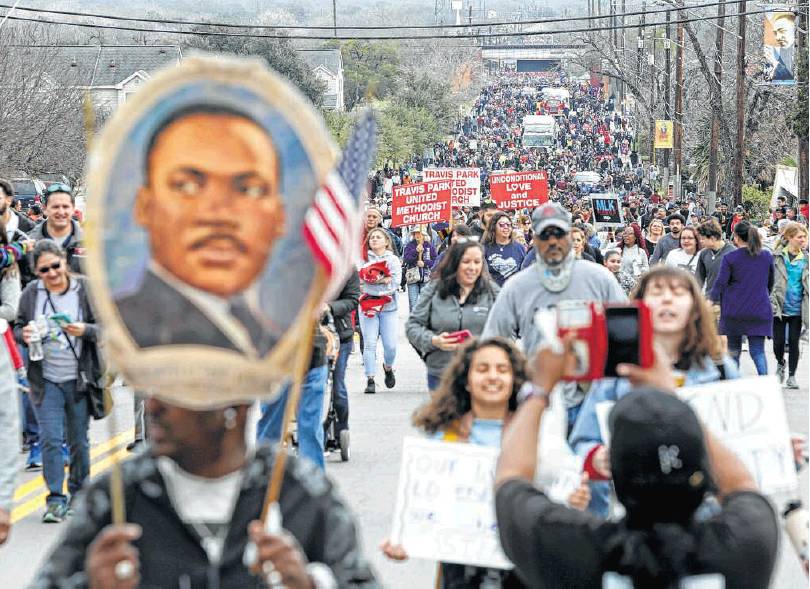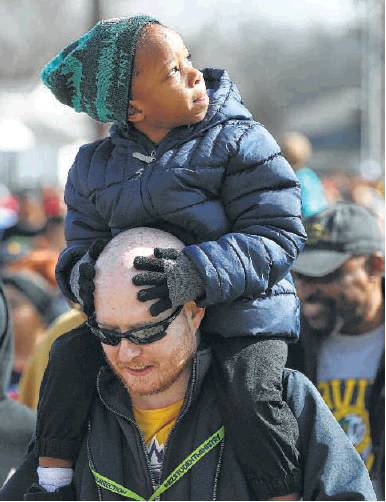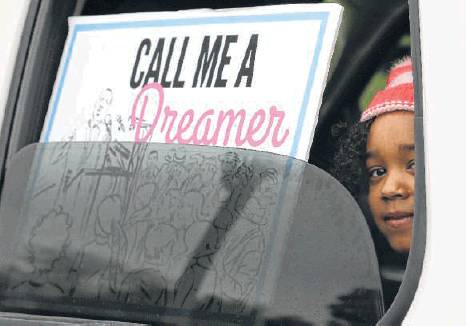History lesson marks MLK March
Speaker says lesser-known parts of ‘I Have a Dream’ still relevant today
By Vincent T. Davis, John MacCormack and Krista Torralva STAFF WRITERS
More than five decades after Martin Luther King Jr. spoke to the nation from the steps of the Lincoln Memorial, schoolchildren know some of the words.
But there was far more to his famous “I Have a Dream” speech Aug. 28, 1963, than lofty, abstract sentiments.
“Dr. King was very much a radical, a revolutionary, but sometimes the way we present him today dumbs down the full power of his words,” said Shaun King, a journalist and civil rights activist who gave the keynote speech Monday at the end of San Antonio’s annual Martin Luther King Jr. March.
In lesser-known parts of the speech, he said, King addressed painful issues that still resonate more than a half-century later.
“He said, ‘We can never be satisfied as long as the Negro is the victim of the unspeakable horrors of police brutality,’” said Shaun King, who named a half-dozen black men killed by police in recent years.
It was a good day for a history lesson, as thousands of people marched down Martin Luther King Drive and gathered under clear skies at Pittman-Sullivan Park. Some came with children and dogs, some came in wheelchairs. Many enjoyed food sold at booths, such as funnel cakes, fried catfish and turkey legs.
It felt like a nice day in the park, and police officers looked on with little to do. More than 100,000 people made the annual MLK holiday march, one of the largest in the country.
For those so inclined, there were uplifting speeches from others including Mayor Ron Nirenberg, U.S. Rep. Lloyd Doggett and Judge Cruz Shaw.
Musical acts ranged from violin virtuoso Daniel Davis, whose version of Marvin Gaye’s 1971 hit “What’s Going On?” brought people to their feet, to a choir of special-needs adults from the the University United Methodist Church who sang “Electric Atmosphere.”
At the close of his keynote, in which Shaun King spoke of his own disappointments and failures in trying to change the criminal justice system, he gave a brief civil rights tutorial. In order to be effective, said King, no relation to the civil rights leader, activists have to be energized and organized and have a well-thought-out plan of action.
Afterward, Jeanine Love, 58, noted that King’s speech was not the usual fare heard on the holiday event.
“He actually educated us with his speech. He went into different parts of the “I Have a Dream Speech” that a lot of people don’t know about. He brought more meaning,” she said.
Sitting with his wife in the third row of the folding chairs, Arlington R. Callies, whose father, the Rev. Dr. R.A. Callies Sr., began the marches in 1968, marveled at what it has become: a grand city-sponsored production.
“It’s emotional at times. My dad would have been 90 this year, and he’s not around to see this,” he said. “I think my dad would have wanted us to know why we marched. We didn’t march because it was a parade. There are things on the East Side that still need to be addressed.”
Hours earlier, Karlotta Polk, 35, and Ariel Marcus, 29, who had traveled from Chicago to take part in the march, joined hundreds of other people at the starting point of the 3-mile route, filling MLK Drive from curb to curb.
“I love the fact that so many different ethnicities come together for one cause,” Marcus said.
Polk said she was impressed by the size of the event that fit in with King’s legacy.
“At the end of the day, Martin Luther King wanted unity, and I think this march is the epitome of that.”
The marchers arrived by chartered buses and private vehicles, with some on horseback. They carried banners, signs and posters with messages supporting King’s philosophy of equality and judging one another not by the color of skin but by content of character.
Six-year-olds Andres Bono and Daniel Rosas held color-marked posters that said, “Love each other” and “Love Wins.”
For some, it’s an annual tradition.
“We’ve been doing this since I was a kid in the early ’90s,” said Zyaire Jones, 26, as she stood behind her great-aunt Elizabeth Forbes, 77, who was in a wheelchair.
Nearby were several members of the Bexar County Buffalo Soldiers Association, who were bombarded by photo requests from marchers.
Dustin Mitchell, 34, the organization’s bugler, said the march was a chance to honor the slain civil rights leader and to share the story of early African-American military veterans.
“Racism is still an issue in the United States,” Mitchell said. “This is an opportunity to teach younger generations their untold history and bring them back to life.”
After the end of an early morning worship service, red and blue lights flashed, signaling the start of a march in which average residents walk with dignitaries.
Among them were former Mayor Henry Cisneros, presidential candidate and former Mayor Julián Castro and his brother, Congressman Joaquin Castro.
People rode bikes, zipped along on skates and rolled by on scooters. Parents pulled children in toy wagons, and some pet owners strolled behind dogs on leashes.
Residents of a senior community on MLK Drive cheered on the marchers as they approached the Interstate 10 underpass. The wind blew a large, long banner that welcomed them to the MLK March and to “Let Freedom Ring.”
Near St. Philip’s College, Otis Thompson, chief elder of the Melanin Society, and three others, held signs that drew puzzled stares.
One read: “Join the NRA.” The others also had controversial messages: “Republicans 4 MLK Park,” “Abortion is evil” and “Build (the) Border Wall.”
Thompson said he merely was exercising his First Amendment rights.
“That’s why I’m able to stand here with this sign, even though some may disagree,” he said. “I have the freedom to do this because we have the baddest military on the planet. I’m a nationalist like the president, not a globalist.”
There were plenty in the crowd who thought otherwise. There were signs that read “Love Trumps Hate”
Todd Beach of San Marcos carried a sign reading “Dump Trump.”
“I want to send a message to everybody in our country: We can do better than this guy. This guy is bringing down the morale of this country, and I’m sick of it,” Beach said.
Maria Gonzalez and Tomas Bello, both 21 and students at the University of Texas at San Antonio from Torreon, Mexico, offered a colorful sign with the words: “Black lives matter, climate change is real, no human is illegal, Love is Love, immigrants and refugees welcome.” They had another poster with the famous MLK quote: “Darkness cannot drive out darkness; only light can do that. Hate cannot drive out hate; only love can do that.”
Jennifer Rosas, 29, said her son, Daniel, learned about the civil rights leader’s speech at school and in documentaries.
“He was trying to fight for black and Latino people to be treated fairly,” said Daniel, 6.
Before the march started, Mary Bozeman, 55, dressed warmly in African regalia, was near MLK Park, meeting up with her contingent of 300 people from St. Philip’s College.
“It’s the epitome and fiber of the Martin Luther King cause,” said the academic program specialist.
For the past five years, Molly and Ford Phillips have staked out a spot at Walters and MLK Drive that offers a view of the diverse waves of marchers.
The couple sat in folding chairs, a few feet from the curb, waving and pumping their fists in the air as the crowd passed by.
Ford Phillips, 66, said it was San Antonio’s diversity that prompted him and his family to move here from Bloomington, Ind.
“It’s like my battery is recharging,” he said.
His wife, Molly, 63, agreed.
“It restores my faith in people’s ability to all come together,” she said of the good feeling she felt from the march. “And to show love to each other.”
“It restores my faith in people’s ability to all come together.”
Molly Phillips, on the good feeling she got from the MLK March



